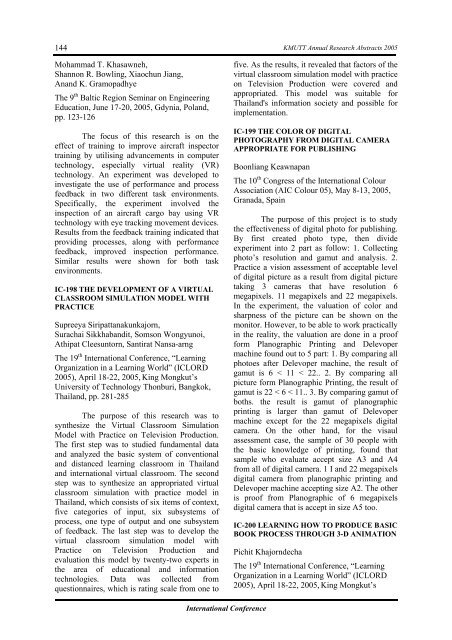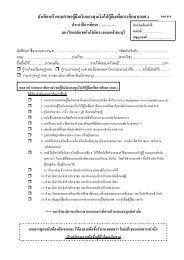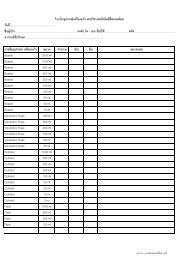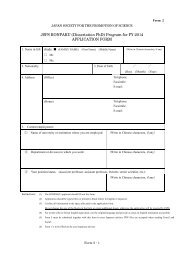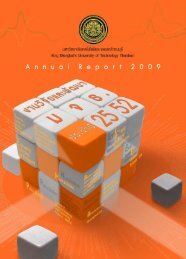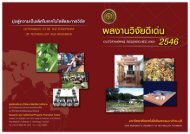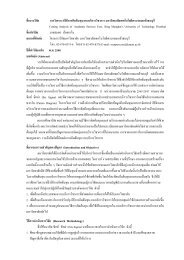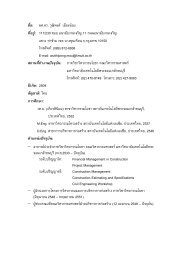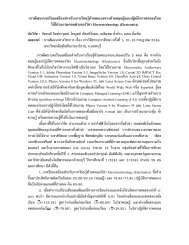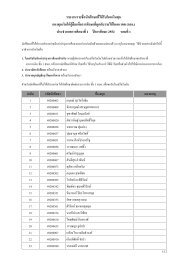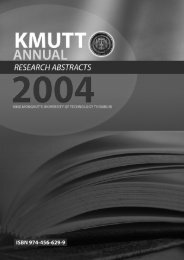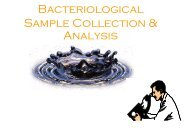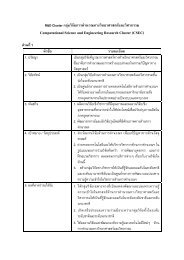You also want an ePaper? Increase the reach of your titles
YUMPU automatically turns print PDFs into web optimized ePapers that Google loves.
144<br />
Mohammad T. Khasawneh,<br />
Shannon R. Bowling, Xiaochun Jiang,<br />
Anand K. Gramopadhye<br />
The 9 th Baltic Region Seminar on Engineering<br />
Education, June 17-20, 2005, Gdynia, Poland,<br />
pp. 123-126<br />
The focus of this research is on the<br />
effect of training to improve aircraft inspector<br />
training by utilising advancements in computer<br />
technology, especially virtual reality (VR)<br />
technology. An experiment was developed to<br />
investigate the use of performance and process<br />
feedback in two different task environments.<br />
Specifically, the experiment involved the<br />
inspection of an aircraft cargo bay using VR<br />
technology with eye tracking movement devices.<br />
Results from the feedback training indicated that<br />
providing processes, along with performance<br />
feedback, improved inspection performance.<br />
Similar results were shown for both task<br />
environments.<br />
IC-198 THE DEVELOPMENT OF A VIRTUAL<br />
CLASSROOM SIMULATION MODEL WITH<br />
PRACTICE<br />
Supreeya Siripattanakunkajorn,<br />
Surachai Sikkhabandit, Somson Wongyunoi,<br />
Athipat Cleesuntorn, Santirat Nansa-arng<br />
The 19 th International Conference, “Learning<br />
Organization in a Learning World” (ICLORD<br />
2005), April 18-22, 2005, King Mongkut’s<br />
University of Technology Thonburi, Bangkok,<br />
Thailand, pp. 281-285<br />
The purpose of this research was to<br />
synthesize the Virtual Classroom Simulation<br />
Model with Practice on Television Production.<br />
The first step was to studied fundamental data<br />
and analyzed the basic system of conventional<br />
and distanced learning classroom in Thailand<br />
and international virtual classroom. The second<br />
step was to synthesize an appropriated virtual<br />
classroom simulation with practice model in<br />
Thailand, which consists of six items of context,<br />
five categories of input, six subsystems of<br />
process, one type of output and one subsystem<br />
of feedback. The last step was to develop the<br />
virtual classroom simulation model with<br />
Practice on Television Production and<br />
evaluation this model by twenty-two experts in<br />
the area of educational and information<br />
technologies. Data was collected from<br />
questionnaires, which is rating scale from one to<br />
KMUTT Annual Research Abstracts 2005<br />
five. As the results, it revealed that factors of the<br />
virtual classroom simulation model with practice<br />
on Television Production were covered and<br />
appropriated. This model was suitable for<br />
Thailand's information society and possible for<br />
implementation.<br />
IC-199 THE COLOR OF DIGITAL<br />
PHOTOGRAPHY FROM DIGITAL CAMERA<br />
APPROPRIATE FOR PUBLISHING<br />
Boonliang Keawnapan<br />
The 10 th Congress of the International Colour<br />
Association (AIC Colour 05), May 8-13, 2005,<br />
Granada, Spain<br />
The purpose of this project is to study<br />
the effectiveness of digital photo for publishing.<br />
By first created photo type, then divide<br />
experiment into 2 part as follow: 1. Collecting<br />
photo’s resolution and gamut and analysis. 2.<br />
Practice a vision assessment of acceptable level<br />
of digital picture as a result from digital picture<br />
taking 3 cameras that have resolution 6<br />
megapixels. 11 megapixels and 22 megapixels.<br />
In the experiment, the valuation of color and<br />
sharpness of the picture can be shown on the<br />
monitor. However, to be able to work practically<br />
in the reality, the valuation are done in a proof<br />
form Planographic Printing and Delevoper<br />
machine found out to 5 part: 1. By comparing all<br />
photoes after Delevoper machine, the result of<br />
gamut is 6 < 11 < 22.. 2. By comparing all<br />
picture form Planographic Printing, the result of<br />
gamut is 22 < 6 < 11.. 3. By comparing gamut of<br />
boths. the result is gamut of planographic<br />
printing is larger than gamut of Delevoper<br />
machine except for the 22 megapixels digital<br />
camera. On the other hand, for the visaul<br />
assessment case, the sample of 30 people with<br />
the basic knowledge of printing, found that<br />
sample who evaluate accept size A3 and A4<br />
from all of digital camera. 1 I and 22 megapixels<br />
digital camera from planographic printing and<br />
Delevoper machine accepting size A2. The other<br />
is proof from Planographic of 6 megapixels<br />
digital camera that is accept in size A5 too.<br />
IC-200 LEARNING HOW TO PRODUCE BASIC<br />
BOOK PROCESS THROUGH 3-D ANIMATION<br />
Pichit Khajorndecha<br />
The 19 th International Conference, “Learning<br />
Organization in a Learning World” (ICLORD<br />
2005), April 18-22, 2005, King Mongkut’s<br />
International Conference


